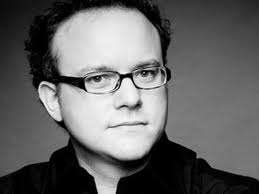|
Back
Studies in a Quantum Mode New York
Zankel Hall, Carnegie Hall
01/21/2013 -
Claude Debussy: Etudes
Elliott Carter: Two Thoughts About The Piano (Intermittences – Caténaires)
Ferruccio Busoni: An die Jugend, Book III: “Giga, bolero e variazione (Studie nach Mozart)”
Harrison Birtwistle: Gigue Machine (US Premiere)
Nicolas Hodges (Pianist) 
N. Hodges (© Marco Borggreve)
The extraordinary program of études played by Nicolas Hodges last night offered two postulates. First, on this Presidential Inaugural Day, that perhaps Jefferson, Franklin, Washington and that British turncoat Thomas Paine were wrong. If they hadn’t declared independence from Great Britain, then we could have claimed Nicolas Hodges as our own.
Second, more seriously, Mr. Hodges proved, beyond any doubt, that a program of seriously modern music (including, most emphatically, Debussy), no barriers exist in idiom and language. As the all-Elliott Carter program at Poisson Rouge showed last week, with just a few bars of an “alien” language, music becomes music, not a reason to ask “Why?” or “What?”. Performing mainstream 19th Century music and then throwing in a Webern or a Birtwistle, like a footnote or a post-nasal drip, never really works.
Then again, how many Nicolas Hodges can there be in the world? The most important composers of our day, from Carter to Birtwistle to Adès have longed to write for a person of his sensibility. In fact, while not mentioned in the program notes, Harrison Birtwistle’s Gigue Machine (co-commissioned by Carnegie Hall) was indeed written for Mr. Hodges particular talents.
And an unsettling piece it is. Gigue Machine is described as part Baroque gigue, part, the “methodical exercising patterns of a machine”. The result is forest of episodes (a few jiggish tunes heard through the underbrush), with so many different rhythms in each hand that one feels the pages (and Mr. Hodges’ hands) could leap off the piano and fall in a writhing mass to the floor. Yes, many a composer, from Liszt to Cowell, has written with different meters at different times, but Birtwistle has turned the concept into a 15-minute dynamo of cross-harmonies, cross currents, different sounds, in what was more a toccata than a gigue. It wasn’t the audacity, though, it was the startling performance.
Equally audacious were two works by Elliott Carter. The first, from a Proust chapter, Intermittences du cœur, was, like Gigue Machine, episodic, but instead of opposition sounds, Mr. Carter worked in a counterpoint of silences. Sometimes a pause, sometimes a measured silence, sometimes, a mad cadenza, like a Nascar auto, coming for a quick rest stop before speeding on. But notes and silences had what seemed a third element, the sustaining pedal. Mr. Hodges used his right foot; like a master organist to give the echoes and staccatos with singular energy.
But nothing (with one exception) displayed Mr. Hodges’ dexterity like Elliott Carter’s second of Two thoughts, Caténaires (French for “catenary”, the shape a hanging chain makes - and don’t say you knew that already!). This piece, without chords or even counterpoint, is a four-minute chain of 16th notes played at such dazzling speed that Mr. Hodges became a virtual centrifuge of fingers and notes. The question wasn’t how he did it, but how he managed to bring a treble lyrical line into the proceedings without stopping the wave/particle movement of Carter’s sub-atomic particles.
Caténaires was written in 2006, when the composer was 102 years old. Debussy, three years before his own death, also composed pieces which were so difficult that not even he could play all of them. That must have been true of the only piece rivaling Caténaires in virtuosity, the sixth of twelve Etudes. Not only must the pianist play a whirl of 32nd notes, but they must be Vivamente, and always light besides. Mr. Hodges accomplished this bagatelle with breathtaking ease.
The others, from the deceptive homage to Czerny, (a simple C major practice scale to a titanic end), and the multi-textured 11th Etude and the last pieces, which had some of the dreamy or gnomic lines from the Préludes.
Another deceptive title was Busoni’s An die Jugend. The “young” in this case were his Master Class students, and the variations on Mozart took one of Mozart’s more difficult last pieces, a supposed “little jig”, K. 574. That Mozart should give such a simple name to such an exhausting piece might have shown his future work.
That is hypothesis. Busoni added few fillips to the original, continued with simple dance from Figaro and finished with Busoni fireworks.
It goes without saying (and without more metaphors about Mr. Hodges’s quantum performance) that they were played with grace, changes of timbre and–for the pianist as well as we poor mortals–absolute delight.
Harry Rolnick
|